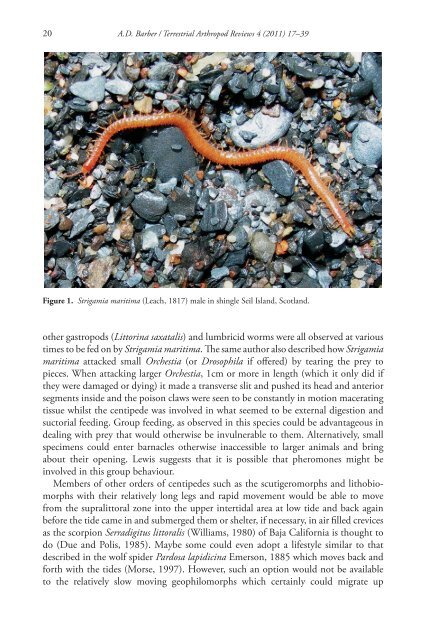Geophilomorph centipedes and the littoral habitat - Books and ...
Geophilomorph centipedes and the littoral habitat - Books and ...
Geophilomorph centipedes and the littoral habitat - Books and ...
You also want an ePaper? Increase the reach of your titles
YUMPU automatically turns print PDFs into web optimized ePapers that Google loves.
20 A.D. Barber / Terrestrial Arthropod Reviews 4 (2011) 17–39<br />
Figure 1. Strigamia maritima (Leach, 1817 ) male in shingle Seil Isl<strong>and</strong>, Scotl<strong>and</strong>.<br />
o<strong>the</strong>r gastropods ( Littorina saxatalis ) <strong>and</strong> lumbricid worms were all observed at various<br />
times to be fed on by Strigamia maritima . Th e same author also described how Strigamia<br />
maritima attacked small Orchestia (or Drosophila if off ered) by tearing <strong>the</strong> prey to<br />
pieces. When attacking larger Orchestia , 1cm or more in length (which it only did if<br />
<strong>the</strong>y were damaged or dying) it made a transverse slit <strong>and</strong> pushed its head <strong>and</strong> anterior<br />
segments inside <strong>and</strong> <strong>the</strong> poison claws were seen to be constantly in motion macerating<br />
tissue whilst <strong>the</strong> centipede was involved in what seemed to be external digestion <strong>and</strong><br />
suctorial feeding. Group feeding, as observed in this species could be advantageous in<br />
dealing with prey that would o<strong>the</strong>rwise be invulnerable to <strong>the</strong>m. Alternatively, small<br />
specimens could enter barnacles o<strong>the</strong>rwise inaccessible to larger animals <strong>and</strong> bring<br />
about <strong>the</strong>ir opening. Lewis suggests that it is possible that pheromones might be<br />
involved in this group behaviour.<br />
Members of o<strong>the</strong>r orders of <strong>centipedes</strong> such as <strong>the</strong> scutigeromorphs <strong>and</strong> lithobiomorphs<br />
with <strong>the</strong>ir relatively long legs <strong>and</strong> rapid movement would be able to move<br />
from <strong>the</strong> supra<strong>littoral</strong> zone into <strong>the</strong> upper intertidal area at low tide <strong>and</strong> back again<br />
before <strong>the</strong> tide came in <strong>and</strong> submerged <strong>the</strong>m or shelter, if necessary, in air fi lled crevices<br />
as <strong>the</strong> scorpion Serradigitus <strong>littoral</strong>is (Williams, 1980) of Baja California is thought to<br />
do (Due <strong>and</strong> Polis, 1985 ). Maybe some could even adopt a lifestyle similar to that<br />
described in <strong>the</strong> wolf spider Pardosa lapidicina Emerson, 1885 which moves back <strong>and</strong><br />
forth with <strong>the</strong> tides (Morse, 1997 ). However, such an option would not be available<br />
to <strong>the</strong> relatively slow moving geophilomorphs which certainly could migrate up









![Am HaSefer [Volk des Buches] - Books and Journals](https://img.yumpu.com/20648352/1/174x260/am-hasefer-volk-des-buches-books-and-journals.jpg?quality=85)







